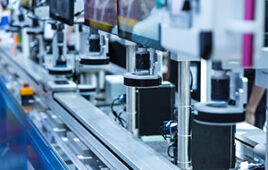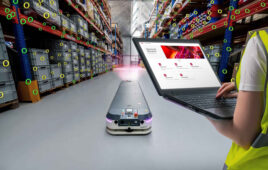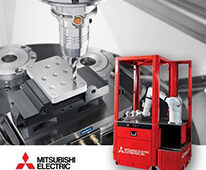by LESLIE LANGNAU, Managing Editor
Experts discuss the changes in technology that will enable greater connectivity and data gathering, and how it will affect your designs.
Overall, the IIoT is primarily a concept—better business operations through knowledge. The basic technology to achieve this concept will be smart sensors, communication buses and analytical software. Vendors are developing creative solutions within these areas.
“We see the IIoT as comprised of three basic technology attributes: intelligence (logic solving, data collection, signal conditioning); networking (wired serial or Ethernet, wireless LAN, cellular, Bluetooth); and communications (protocols and APIs),” said Ben Orchard, applications engineer at Opto 22.
The ability to have data at your fingertips, thanks to recent technology developments like mobile platforms, is part of what’s driving the implementation of wider connectivity. Noted Gary Marchuk, director of business development at AutomationDirect, “Our customers have constantly demanded that they have the ability to access data from their HMI or PLC on their cell phone or tablet.”
But existing networks will not disappear. “Instead,” said Armin Pühringer, business development manager, Hilscher Gesellschaft für Systemautomation, “our networking infrastructures—particularly at the higher levels—will have to be changed to deal with Big Data and its potential.”
A technology helping to push the limits of what was previously thought possible for data collection and communication is the field programmable gate array (FPGA). “Through FPGAs, we’ve distributed intelligence down to the I/O slice level like never before,” said John Kowal, director, business development at B&R Automation. “We have a slice that closes the loop internally in one microsecond, without needing to go up to the PLC CPU first.”

Other technological changes Kowal is seeing include affordable accelerometers. Thanks to the smartphone, these accelerometers can be used to monitor key bearings for predictive maintenance.
And technology can take things even further, soon. Added Kowal, “We can put software algorithms in servo drives to smooth out disturbances before they have an impact on the drivetrain.”
Another area that design engineers will see improvement will be security for communications. As recent news reports indicate, everyone will need to determine how best to secure not only the data, but the machines and systems sending the data. Secure transmission will be a requirement for the IIoT to become a reality on the factory floor.
Data security in cloud-based systems can be assured through standards like OPC UA with its built-in data encryption in horizontal communication architectures.
But part of getting more data out of automation processes means much more connectivity than is working today. Noted Will Healy III, strategic marketing manager, Balluff, “Visibility into the manufacturing process requires that even some of the lowest devices need to be seen and communicated to. Getting visibility to thousands of sensors and actuators on a production line would require dramatic investment in Industrial Ethernet architecture to implement IoT in every device.”
For some, this investment involves the open standard IO-Link. IO-Link technology uses a master device talking on Ethernet and provides access to multiple smart sensors. IO-Link field devices can communicate diagnostic information and preventative warnings and can receive parameters for configuration.
Other technology that engineers will see includes scalable performance CPUs and software tools that represent the convergence of automation technology (AT) and Information Technology (IT). “Developments in cloud-based systems and services, such as Microsoft Azure and Amazon Web Services, represent ideal platforms to store manufacturing data sent from connected machine controls,” said Daymon Thompson, TwinCAT product specialist, Beckhoff Automation.
While vendors of more proprietary, “closed” architecture systems must develop products that can implement web- and cloud-based solutions, PC-based controls have quickly adapted to new protocols and cloud connected technology without the need for new hardware offerings.
Communication keys
One challenge now with IIoT installations, is that most do not use a standard Ethernet based protocol. While Ethernet is commonly used by just about everything, it’s not a “plug-and-play” setup. Some vendors are urging a more cohesive approach.
“Several leading players in industrial automation, such as Festo, have products that communicate over a range of industrial network protocols including Ethernet based protocols such as EtherCAT, Profinet and Ethernet/IP,” said Nuzha Yakoob, product manager, Positioning, Festo. Connecting to the enterprise level, though, typically involves PLCs or gateways.
Hilscher also offers a chip family that connects to all popular automation network protocol stacks with one driver interface. The netX chip family supports interoperability of different standards and communication systems.
Some argue that to increase productivity and profitability, a single network platform is necessary. A single network lets manufacturers take advantage of advanced cloud services and data driven manufacturing, and can also provide greater security throughout.
“Thanks to advances in wireless technology,” said Doug Bellin, global senior manager for Manufacturing and Energy, Cisco, “users can add more data-gathering end points onto a network. As wireless speeds reach those of a traditional wired network, new opportunities arise for real-time monitoring, analytics, and computing at the edge, also known as fog computing.”
Another example of a cohesive communication approach is the Connected Enterprise from Rockwell Automation. This approach should boost the advantages of smart, safe, secure and sustainable manufacturing and industrial operations. Users benefit from faster time-to-market, lower total cost of ownership, improved asset useage and enterprise risk management.
Central to achieving The Connected Enterprise, or any smart manufacturing initiative, is the need to converge information technology (IT) and operations technology (OT). Some companies, like Rockwell, are aligning with other IT and OT market leaders—like Cisco, Microsoft, Panduit and AT&T. Rockwell aims to continue to drive The Connected Enterprise vision forward and help solve real-world customer problems that cannot be solved without such cooperation.
In the future, with the implementation of Industry 4.0 there will be only one, worldwide standard protocol—an Internet protocol based on a real-time capable WLAN or Ethernet.
From raw to useful
Another huge challenge will be dealing with all the gathered data that will be sent wirelessly. Some projections say there will be Terabytes of data sent wirelessly every day! Manufacturing, management and engineers will need sophisticated analytic programs to turn raw gathered data into meaningful and actionable information.
Noted Colin Geis, product marketing manager, Red Lion Controls, “One key IIoT development will be protocol conversion. This function will help users deal with the challenge of gathering data from all the different connectivity/communication protocols used by manufacturing floor devices.”
One example of such a program is the Historian data management platform that GE has been using for years to capture data without having to archive them. “When you have that amount of data at your fingertips,” said Bob Gates, global marketing director, GE Intelligent Platforms, “you can better understand correlations, look at what you were able to do versus what you are doing now and conduct this analysis with specific products and materials. It’s no longer anecdotal that you need product A followed by product B to run the plant equipment more efficiently. Now it’s product B followed by product A and the why is because you have the validation through data.
Another example is Rexroth’s Open Core Interface. It provides a software development kit for the company’s motion control systems in different programming platforms. “The benefit is that they have quick and easy access to our ‘things’ and other ‘things’ connected to our control without needing to know our programming software,” said Allen Tubbs, program manager, Electric Drives and Controls, Bosch Rexroth. “The continued growth of cheap and affordable processing power enables smart products. Thus, you can offload processing power, enabling devices to think on their own, collecting and processing their own data and communicating only relevant data back to other systems.”

Schneider Electric offers several examples of IIoT ready components. “We have a number of products with dynamic QR codes for smart diagnostics,” said Matt O’Kane, VP, Industry Business, Schneider Electric. “Our Altivar Process drives are the first with embedded intelligence to help with big data and analytics applications. Additionally, our Vijeo Design’Air mobile app for the configuration of control devices increases the speed of commissioning and helps reduce plant downtime.”
PTC offers the ThingWorx IoT development platform to enable better service, more uptime and differentiated product design for developers of smart, connected products. With this platform, designers can include functions that unify visibility, trigger alerts, and develop analytics that help improve operational performance and reduce wast.
But should everything be connected to the Internet? A direct connection may not be the best approach. “While developments in microprocessors make more diagnostic, status, configuration and preventative maintenance data available,” said Randy Durick, VP, Network and Interface Div., TURCK, “in many instances, it may not make sense to directly connect field devices to the Internet. Here, innovative fieldbus technology has a strong place. In this scenario, the field device still has a microprocessor that eases device configuration and diagnostic data, but given the number of field devices in some larger applications, it may not make sense to connect directly to the IIoT. However, in using some device-level protocol and elevating this information to the Internet or Ethernet through an I/O device, a user has essentially connected the device to the Internet.”
Of course, sensors are the nerve endings of the Internet backbone and will play a huge role in the IIoT. An example is the IntelliSense sensor from Bimba. “For use on pneumatic actuators, this sensor collects and analyzes data at the actuator level to gain insights into how the actuator is performing and to have a sound basis for considering improvements,” said Jeremy King, product marketing manager, Bimba Manufacturing.
And finally, IIoT technology will speed the development of documentation. Noted Anthony Varga, president, Canada, SVP North America Strategic Sales, Rittal, as manual processes convert to automation, any changes made to products can also be automated. Drawings, schematics, bills of material, 2D and/or 3D layouts, manufacturing lists and instructions can be simultaneously revised, reducing opportunities for error and the subsequent need for expensive rework.
References
AutomationDirect
www.automationdirect.com
Balluff
www.balluff.com
Beckhoff Automation
www.beckhoffautomation.com
B&R Automation
www.br-automation.com
Bimba Manufacturing
www.bimba.com
Bosch Rexroth
www.boschrexroth-us.com
Cisco
www.cisco.com
FESTO
www.festo.com
GE Intelligent Platforms
www.geautomation.com
Hilscher Gesellschaft für Systemautomation
www.hilscher.com
Opto 22
www.opto22.com
PTC
www.ptc.com
Red Lion Controls
www.redlion.net
Rittal
www.rittal.com
Rockwell Automation
www.rockwellautomation.com
Schneider Electric
www.schneider-electric.com/us/en
Siemens Digital Factory
usa.siemens.com
TURCK
www.turck.us
Filed Under: Factory automation, MORE INDUSTRIES





Connectivitiy is in IIoT applications is the most underestimated technical challenge. Compared to smart home in IIoT applications the user of a smart device can´t use his own network to have access to the internet an cloud platforms. A smart machine hundreds or thousands of kilometers away will not have access to a network in foreign companies in foreign countries in foreign mobilnetworks. So Wifi and ethernet is in most cases not available. To use mobil radio connectivity sounds first as a possible way, but there are a lot of snares. Normally SIM cards as the physicall part of a mobil radio contract is not designed to work in devices where no user is part of the game.
Schildknecht AG in Germany offers IIoT gateways which works in 150 countries wih 400 cellular providers